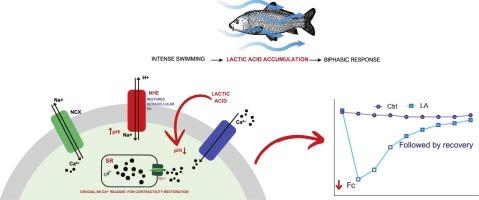A mechanistic investigation of the effects of lactic acidosis on myocardial contractility in the Neotropical fast-swimming freshwater fish Brycon amazonicus
IF 4.3
3区 环境科学与生态学
Q2 BIOCHEMISTRY & MOLECULAR BIOLOGY
Comparative Biochemistry and Physiology C-toxicology & Pharmacology
Pub Date : 2025-07-23
DOI:10.1016/j.cbpc.2025.110299
引用次数: 0
Abstract
Lactic acidosis commonly impairs myocardial contractility in vertebrates, limiting cardiac performance under metabolic stress. However, the rheophilic Neotropical species matrinxã (Brycon amazonicus) appears to exhibit physiological adaptations that support cardiac resilience. In this study, ventricular muscle strips were exposed to extracellular lactic acidosis (LA, 22 mM lactic acid, pH 6.9) and evaluated for twitch contractility and the roles of calcium handling and pH regulation. Isometric ventricular preparations were utilized to assess: (a) the effects of LA; (b) the combined effects of LA and ryanodine, an inhibitor of sarcoplasmic reticulum (SR) function; (c) the combined effects of LA and amiloride, an inhibitor of the Na+/H+ exchanger (NHE); (d) the effects of lithium, an inhibitor of the Na+/Ca2+ exchanger (NCX), and its interaction with LA; and (e) the effects of a Ca2+-free solution and its interaction with LA. Acidosis initially reduced contractile force, followed by a complete recovery and accelerated relaxation. Ryanodine and amiloride effectively abolished recovery, whereas Na+/Ca2+ exchanger blockade enhanced force but prolonged relaxation. Compared to other acidosis-resilient fish species, our findings show that B. amazonicus employs a distinct adaptive strategy to maintain cardiac function under lactic acidosis. This strategy involves coordinated sarcoplasmic reticulum (SR) Ca2+ release and activation of the NHE to restore myocardial performance. Such physiological adjustments likely support survival during intense anaerobic activity in fluctuating aquatic environments.

乳酸酸中毒对新热带快游淡水鱼亚马逊Brycon amazonicus心肌收缩力影响的机制研究。
乳酸性酸中毒通常会损害脊椎动物的心肌收缩力,限制心脏在代谢应激下的表现。然而,嗜流的新热带物种matrinxã(亚马逊Brycon amazonicus)似乎表现出支持心脏恢复力的生理适应。在这项研究中,将心室肌条暴露于细胞外乳酸酸中毒(LA, 22 mM乳酸,pH 6.9),并评估抽搐收缩力以及钙处理和pH调节的作用。采用等长心室制剂来评估:(a) LA的作用;(b) LA和ryanodine(一种肌浆网(SR)功能抑制剂)的联合作用;(c) LA和Na+/H+交换剂(NHE)抑制剂amiloride的联合作用;(d) Na+/Ca2+交换剂(NCX)抑制剂锂的作用及其与LA的相互作用;(e)无Ca2+溶液的影响及其与LA的相互作用。酸中毒最初减少收缩力,随后完全恢复并加速松弛。Ryanodine和amiloride有效地消除了恢复,而Na+/Ca2+交换剂阻断增强了力,但延长了松弛时间。与其他抗酸中毒的鱼类相比,我们的研究结果表明,亚马逊贝类在乳酸酸中毒下采用了独特的适应策略来维持心脏功能。该策略涉及协调肌浆网(SR) Ca2+释放和NHE的激活,以恢复心肌性能。这种生理调整可能支持在波动的水生环境中进行剧烈无氧活动时的生存。
本文章由计算机程序翻译,如有差异,请以英文原文为准。
求助全文
约1分钟内获得全文
求助全文
来源期刊
CiteScore
7.50
自引率
5.10%
发文量
206
审稿时长
30 days
期刊介绍:
Part C: Toxicology and Pharmacology. This journal is concerned with chemical and drug action at different levels of organization, biotransformation of xenobiotics, mechanisms of toxicity, including reactive oxygen species and carcinogenesis, endocrine disruptors, natural products chemistry, and signal transduction with a molecular approach to these fields.

 求助内容:
求助内容: 应助结果提醒方式:
应助结果提醒方式:


